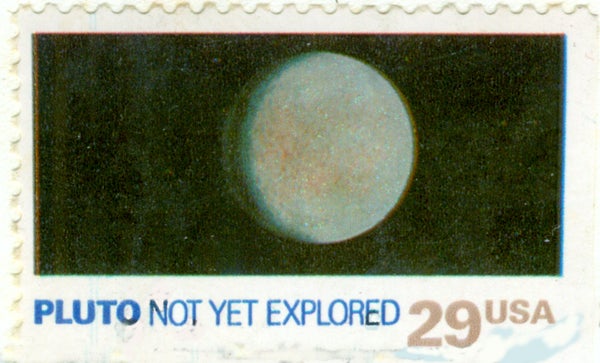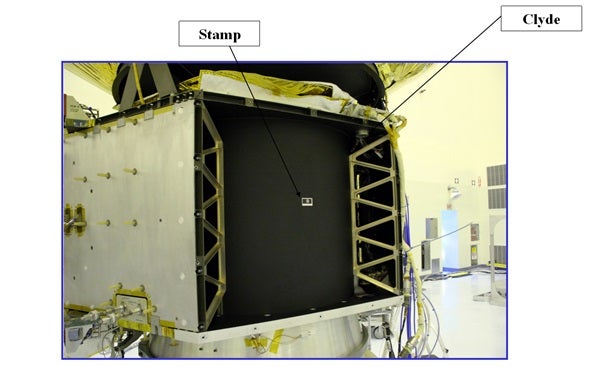How much does shipping cost to the Kuiper Belt? Apparently, if you go via the U.S. Postal Service, it’s just 29 cents.
The 1991 stamp designed by longtime Astronomy magazine contributor Ron Miller is among the nine earthly mementos New Horizons carries in its Pluto-bound cargo. And, in a strange way, the stamp helped get New Horizons started by irking some of the very scientists it was meant to honor.
On the heels of Voyager’s final flyby at Neptune, the U.S. government commissioned Miller for 10 illustrations — one for every planet, plus the Moon. Each stamp ran with an image of the spacecraft that explored it. But for the ninth planet, the text simply read, “Pluto: Not yet explored.”
The stamps were unveiled in a ceremony at the Jet Propulsion Laboratory (JPL) in Pasadena, California, where many of the exploration efforts were centered. JPL’s Robert Staehle would later recount the tale in an article titled “To Pluto by way of a postage stamp.”
Staehle says that after the ceremony, he and JPL scientist Stacy Weinstein discussed what they’d do about the “Not yet explored” travesty. Their work would soon merge with the efforts of others already well underway (including the Pluto Underground) and spawn the Pluto 350 project.
New Horizons Principal Investigator Alan Stern wanted to flaunt the juxtaposition as NASA reconnoitered the last unexplored planet.
“It was my idea to send it. For many years, people had waved that stamp around as sort of a call to arms — as a motivating graphic — ‘Not yet explored,’” Stern said in a recent interview with Astronomy magazine. “That stamp had been in so many presentations by that point, I knew it would please people to have it go along.”
After his team won the competition and built New Horizons, he says he knew they had to “send the canceled stamp to Pluto.” And Stern hopes the U.S. Postal Service will issue a new commemorative stamp once Pluto is officially explored next month. The Southwest Research Institute where Stern works launched a petition several years ago encouraging them to do so.
I recently chatted via email with Miller about what it’s like to have his art soaring toward the solar system frontier and how it happened.
Eric Betz: How did your official stamp series come about in 1991 and what was the response at the time?
Ron Miller: It was done at the instigation of Howard Paine, who was at the time the art director at National Geographic. He was also a member of the Citizen’s Stamp Advisory Committee.
I don’t really recall how we got in touch originally or who first suggested the idea. I do know that the stamps were originally to be just of the solar system’s worlds alone. However, the other members of the committee thought that the stamps should have a more American connection, hence the addition of a spacecraft that was relative to each world except, of course, for Pluto.
EB: How did the “Not yet explored” stamp actually find it’s way onto New Horizons?
RM: I’ve only seen a photo of the stamp on the spacecraft, but I believe it is in some sort of protective sleeve. Anyway, although there was no direct one-to-one relationship between the stamp and New Horizons, Alan [Stern] did know that the “Not Yet Explored” had rankled a lot of scientists. It had already been the inspiration for one earlier proposed Pluto mission. In 1993, JPL engineer Robert Staehle explained this in a paper titled, “To Pluto by way of a postage stamp.” “During 1991,” he wrote, “with Voyager 2’s Neptune encounter two years behind us, the U.S. Postal Service issued 10 stamps commemorating the success of planetary exploration. On a stamp for each of the first eight planets and the Moon appeared an illustration of the celestial body with one of the spacecraft which visited it. The stamp for Pluto simply announced, NOT YET EXPLORED, as if to taunt engineers and scientists at Pasadena’s Jet Propulsion Laboratory (JPL), where the stamp were unveiled in a first-day-of-issue ceremony on October 1.”
On that same day, Staehle stopped by the office of his friend Stacy Weinstein, of JPL’s Advanced Projects Group, with the Pluto stamp. Staehle “jokingly asked what we were doing about this travesty of ‘Pluto – Not Yet Explored.’” That was when “the mission was born,” Staehle concluded.
EB: As an artist who’s illustrated this unexplored planet for decades, including for Astronomy magazine, what does it mean to you to have your stamp fly past Pluto?
RM: Well, I’ve certainly never had any of my artwork travel so far from the Earth! In fact, unless I’m mistaken, only the Voyager plaque has traveled farther. I like to think of the stamp as allowing me to vicariously explore the solar system. I do hope, though, that the stamp was cancelled, otherwise in about 15 years the spacecraft is going to wind up right back here.
Eric Betz is an associate editor of Astronomy. He’s on Twitter: @ericbetz.











